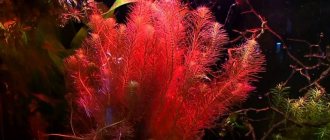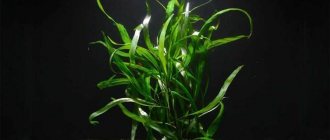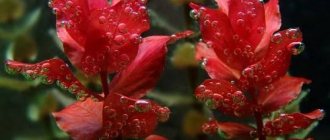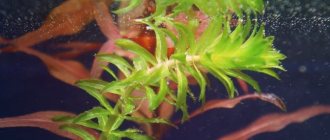An aquarium without living flora looks dull and empty. Rotala indica is considered a common glass house decoration. A moderately whimsical ornamental plant will decorate an aquarium, paludarium and greenhouses with a humid climate. A special maintenance condition is that at temperatures below 200C, some types of rotala die.
At temperatures below 20C, some types of rotala die.
Getting to know the plant
The general public is more familiar with Indica Rotala as an aquarium plant than as a weed in rice fields. The grass originated in the tropical reservoirs of Southeast Asia. Grows in shallow waters in weakly flowing water. Clinging to the bottom of the reservoir with a creeping rhizome, it forms dense purple thickets with almost half a meter of erect stems. Small (1 - 2.5 mm) succulent leaves add color to the plant. Shoots above the surface bloom.
In the water column, the leaves are ovoid and elongated; they are arranged oppositely and loosely on the stem. Above the surface they are rounded, thickened, and acquire a characteristic glossy sheen. Pink flowers appear in the leaf axils.
The genus name rotalis is translated from Latin as “having wheels.” It is not in vain that Indica Rotala got its name - it now travels around the world, although the official reason for naming the plant was the whorled arrangement of the leaves.
As an introduced species, Indica Rotala successfully infests the rice plantations of Congo, Italy, and Portugal. It grows in the tropical climate of California and Louisiana. It is also found in the wetlands of subtropical Transcaucasia.
A part of the huge genus of plants Rotala, the aquatic grass Rotala indica, was studied and systematized by the German botanist K.L. Wildenov at the beginning of the 19th century:
| Chapter | Name |
| Kingdom | Plants |
| Family | Derbennikovye |
| Department | Angiosperms |
| Class | Rozoids |
| Squad | Myrtaceae |
| Genus | Rotala |
Since 1960, there has been confusion among aquarists regarding the names of the species. Rotala rotulifolia was often called Indian. They got the true plant in 2009 under the name Ammania “Bonsai”. The error was corrected in 2013.
Features of an aquarium plant
The artificial habitat leaves its mark, giving the plant its own flavor. The bush grows quickly, within a month, but is low to 25 cm. The diameter of the juicy round stem is up to 2 mm. Ideal for small aquariums. New shoots emerge from numerous buds of the rhizome, forming a lush tussock. In the water column, the stems are elongated and pressed tightly against each other; on the water surface they form a rounded shape.
Weak roots and a minimum of absorbed nutrition allow the use of Indian Rotala both rooted and floating.
Rotala does not bloom under water; its decorative appearance is represented by bright leaves. Their color scheme depends on the saturation of light rays: light green, emerald, red-brown, with a pink or purple tint. The expressiveness of grass is indispensable in creating fantastic aquarium compositions.
Description
Quite rarely, but you can still see beautiful bushy thickets in aquariums, emphasizing the structural depth of the background. This is Rotala - a representative of the Derbennikov family (Lythraceae). Unfortunately, the plant is not very common among aquarists in Russia, and even less often it can be found in greenhouses. This is explained simply: Rotala is quite capricious, its cultivation is fraught with considerable difficulties. However, the plant fully pays for all the effort invested. An aquarium planted with various species of this herbaceous perennial can amaze the imagination. Rotala has many faces. To date, 30 species have been recorded, and each of them differs from its counterparts. Stems covered with opposite, slightly wavy leaves; twigs resembling pine; strong shoots with rounded foliage - all this is Rotala.
When creating this long-stemmed plant, nature took care to maintain balance. Despite all its demands, Rotala is growing quite quickly. With the right approach, in a few weeks single shoots can turn into dense ornamental thickets. Their colors, ranging from rusty red to bright green, add zest to the decor of the aquarium and serve as an excellent background for other plants.
Rotala can also be grown outside of an aquarium. In this case, the plant develops strong, elastic shoots. Small flowers may also appear in the leaf axils. In an aquarium, the plant reaches 25 cm in height; in the air, the shoots can stretch up to 50 cm.
Indica Rotala - jackpot for the aquarium
Indica is valued not only for its exotic hydrophyte, but also for its ability to maintain the biological balance of the biosystem environment. In the Rotala aquarium, Indian serves as a kind of filter, participating in metabolic processes:
- absorbs carbon dioxide;
- produces oxygen;
- neutralizes excess nitrates and phosphates.
The grass is considered a “litmus test”, reacting with the color of its leaves to any changes in water balance.
11:27
Signs of a lack of Microelements in the Aquarium. Clearly! Filamentum on Moss Xenococus on Anubias
07:16
Aquarium plants. Rotala macrandra and fertilizer dosages for it.
06:49
Overdose of microfertilizers in the aquarium. Incorrect pruning of plants.
Fish like to eat rotala indica. It is better not to use it with those digging the bottom, because, raised from the bottom, the suspension will destroy the plant.
Useful features
The unpretentious and spectacular rotala rotula has a beneficial effect on the harmony of the environment in the aquarium and, of course, on the appearance of the home pond.
- Saturates water with oxygen.
- Neutralizes harmful substances formed in the environment.
- Rotala roundifolia serves as a kind of indicator of water hardness.
- Its appearance and color of the leaves indicates insufficient or excessive illumination of the aquarium.
- Rotala bushes can become a refuge for fry or small fish with a peaceful nature.
Also, the rapid growth of grass provides ample opportunities for aquarium design - with its help, you can realize your ideas for the appearance of the underwater landscape in a very short time. And the unusual color of the plant looks advantageous and original both against the background of dark and light greenery. It is most effective to combine rotala bushes with plants that have large leaf blades - this creates a beautiful contrast.
This is a truly versatile, interesting plant. A big plus is also its low cost. It is not for nothing that Rotala indica grows successfully in the aquariums of beginners and real aquarium gurus, decorating home ponds and performing its useful functions in them.
Return to content
Variations of the species
There are few varieties of Indian Rotala; subspecies differ in the number of leaf blades in the whorl. There are 2, 3 and 4 leaf specimens. The 2-sheet form remains more aesthetically pleasing for a long time. The leaves of this hybrid are large, 2 cm long and about 5 cm wide.
In other variants, the leaves are narrower; due to thickening, the upper leaves shade the lower ones. From lack of light they fall off, leaving the stem bare. There is a way out: place the grass in the background, covering the bare stems with large-leaf plants.
Acid-base balance
The most suitable water reaction is pH 6-7, slightly acidic or neutral. If the indicators go beyond the optimal limits, growth will slow down and the plant will stop developing. And in a highly alkaline environment, the plant may die. An acid reaction is also not suitable.
If the water pH is below 6, ammonium and nitrite compounds accumulate, which are harmful to plants and fish. At a pH of 8 or more, an alkaline environment, there is an excess of ammonia, which is dangerous for all inhabitants of the aquarium.
Strong acidity is caused by rare cleaning of the soil, where food residues and fish waste products accumulate. To neutralize the reaction, you need to add a special alkaline product, which is sold in pet stores. Strongly alkaline water must be changed with a product that contains a weak acid.
Vladislav Komisarzhevsky - Art. manager, Rostov-on-Don.
If it is not possible to purchase ready-made products, you can use the available substances:
- Neutralization of acidic water is carried out using baking soda;
- Alkalinity is reduced by adding special acidic peat.
Conditions of detention
Even a novice aquarist can grow an unassuming hydrophyte. If the fish are comfortable in the aquarium, then the grass feels great. Given the origin of the plant, it is preferable to keep Indica Rotala in tropical conditions.
Water environment
In nature, Indica grows in slightly flowing water, so it is enough to replace a quarter of the volume once a week. Weed is more demanding in terms of acidity and hardness. It feels better in neutral or slightly acidic water, pH in the range of 5 – 7, GH 2 – 12°.
No less picky about temperature, yet it is a tropical crop. Maintaining parameters of +24 – 28°C will have a positive effect on her appearance and health. No additional supply of carbon dioxide is required; its concentration in water is sufficient.
Priming
Indica rooted Rotala looks more aesthetically pleasing. Although it is not picky about the composition of the substrate, it is nice if it is neutral and supplemented with a small amount:
- clay;
- peat;
- silt.
Together with pebbles, the thickness of the layer is 5 cm. The presence of silty compounds will provide Indica with long-term nutrition and additional feeding will not be needed.
You can buy soil for aquarium plants ready-made or make it yourself.
Lighting
The saturation of the light rays affects the aesthetics of Rotala. In shaded conditions, the leaves turn pale and the stem becomes elongated, so additional lighting is used. Light the aquarium for up to half a day. Optimal light intensity is 80 – 100 Lm/l. If the plant is comfortable, it actively begins to grow, and the leaves turn red.
Indica Rotala tolerates short-term shading, but excess light radiation turns out to be destructive and threatens the appearance of algae that are dangerous for the grass.
Diseases
Changes in leaf color and wilted appearance indicate a violation of the following rules:
- untimely fluid change;
- excessive lighting;
- proximity to blue-green algae;
- placing filter or aerator tubes next to the bushes;
- working with the plant without gloves or tweezers;
- prolonged exposure of the roots of the seedling when transplanting outdoors;
- soil quality.
If the grass has died, it is necessary to promptly remove the rotten stems.
Indica will be healthy if: it lives in a clean aquarium without “bearded algae” and the like, in renewed water and high-quality soil, it has enough nutrition, the duration and brightness of lighting is maintained at normal levels.
Planting, care, reproduction
To get a new Indian Rotala plant, it is enough to cut cuttings with 3–4 internodes and let them float freely on the surface of the water. When roots appear, immediately plant the cutting vertically in the ground, otherwise Indica will stunt growth.
03:01
Indian rotala (Rotala indica)
08:03
Added to the herbalist Rotala H»Ra
06:32
Indian rotala haircut (rotala indica)
Planting with several stems looks more impressive than a single plant. Even from one cutting, a full-fledged bush is obtained by pinching the top of the shoot. The grass grows quickly; within a month a fluffy tussock appears. Periodic thinning will protect against shade and leaf loss. Once a month, it is enough to cut out the bare stems and leave suitable cuttings for seedlings.
Hardness of water
To determine this indicator, aquarists use the German scale of total water hardness. The unit of measurement symbolizing this indicator is the degree of hardness, expressed by the symbol dH.
To determine the state of water in the aquarium, you can use the following table:
| Hardness degree (dH) | Characteristic |
| 0-40 | Very soft |
| 5-80 | Soft |
| 9-120 | Average |
| 13-220 | Tough |
| 23-340 | Very hard |
You can determine the indicator using special reagents that are sold in a pet store. You can also use hardness test meters or test strips.
Important! When caring for rotala indica, you should make sure that the water hardness corresponds to dH 6-120.
Reviews and advice for beginners
Although Indica Rotala appeared relatively recently among aquarists, it has already caused a lot of controversy. Some consider it a “plant for the lazy,” others consider it a finicky herb. However, their discussions provide invaluable assistance to beginners. Here's what they recommend:
- Large herbal plants with a variety of species require fertilizers, and Indica Rotala is sensitive to copper, boron, and iron content. Before feeding, you need to remove the bushes from the aquarium.
- Choose artificial light in the red-orange range.
- Shoots that escape the water column begin to bloom, while those that have faded lose their decorative effect. They should be pinched at the surface of the water.
- If the Indica leaves appear larger and brighter near the water surface than at the bottom, CO2 should be added.
Beginners need to be careful and careful when using fertilizers - Indica Rotala is very sensitive to excess micro and macroelements.
The unassuming universal hydrophyte Indica Rotala is increasingly interested in landscapers. Not only the decorative and cleansing functions of the grass attract their attention, but also the affordability of the price.
Lighting
Full growth and spectacular decorative effect occurs only with sufficiently good lighting.
- Natural sunlight is preferable.
- In partial shade, the shoots stretch out , become thin, the leaves become smaller and become pale and expressionless. Culture is losing its attractiveness.
The health of a plant can be determined by the color tone of the leaves. If there is enough light, a pinkish or reddish tint appears.
The duration of daylight should be at least 12 hours, at any time of the year.
How to plant
This plant can be cultivated in water without any substrate - in this case, it will receive all the beneficial elements it requires directly from the aquatic environment. However, when grown in aquarium soil, the grass grows much faster, so the following is an option for planting rotala in the soil.
A comfortable thickness of the soil layer is 2–3 cm. This is quite enough for this plant, since it has a creeping rhizome. Small pebbles with clay are best suited as a soil mixture. The soil should be lightly covered with water.
It is also important to choose the right place in the artificial reservoir where the Indian guest will develop. Plant vegetation closer to the back wall and side walls of the vessel so that it does not interfere with the contemplation of the inhabitants of the aquarium, serving as a beautiful background for them.











